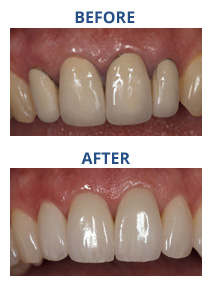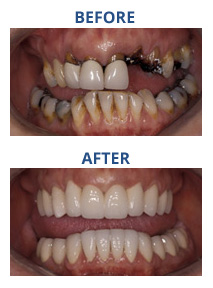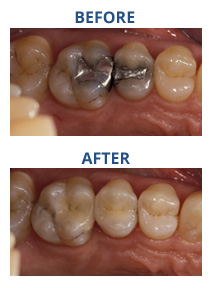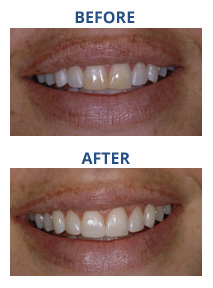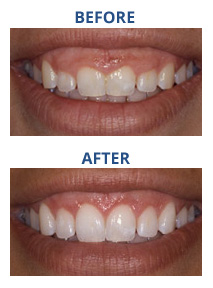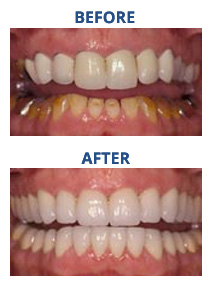Restorative Dentistry

THE ART AND SCIENCE OF SMILE DESIGN.
We blend artistry with precision to help you achieve a stunning, naturally beautiful smile. So, what defines a truly great smile? For us, it comes down to four key qualities: color, contour, balance, and durability. Color speaks to the whiteness and luminous quality of your teeth—they should be bright but still look naturally translucent. Contour refers to the shape of each tooth; chips or misalignment can take away from an otherwise lovely smile. Balance is all about the harmony between the teeth and the gum line. And finally, durability represents the strength and function of your teeth—because a smile isn’t just about appearance; it’s about health, too.
Crowns
Crowns are restorations that are similar to veneers, except they cover the entire tooth. They are used to fix teeth that are badly damaged or worn, have large cavities, or have undergone root canal therapy. Crowns are also used to strengthen weakened teeth. Adjacent crowns can be connected together to stabilize loose teeth.
Crowns can be constructed from various materials. No matter the material or construction technique, crowns can help restore the look, strength and bite function of natural teeth.
Bridges
Bridges are like crowns, except they are used to replace a series of missing teeth. Generally composed of porcelain or porcelain fused to gold, bridges are made to “bridge the gap” created by missing teeth.
There are three types of bridges:
- The first is called a conventional fixed bridge, which consists of a replacement tooth fused between two crowns to fill the gap.
- The second is a cantilever bridge, which is a replacement tooth anchored to a crown on one side of the open space. It is not as strong as a conventional fixed bridge, but it can be used in situations where it will not receive heavy function.
- The third type is a resin bonded bridge, and is generally used for missing front teeth when there are healthy teeth with no restorations on either side. In these cases, the replacement teeth are fused to metal bands that are bonded to the adjacent teeth with resin cement.
Like crowns, bridges can restore natural beauty and function to your smile.
Porcelain Inlays and Onlays
Inlays and onlays are ideal for repairing small cavities or replacing old mercury (amalgam) fillings. Traditional metal fillings can lead to cracks and darkening of the tooth over time. In contrast, inlays and onlays are crafted from tooth-colored porcelain or composite resin, making them blend seamlessly with your natural teeth and nearly invisible when placed.
Inlays and onlays also conserve more of your natural tooth structure, and when bonded in place, can strengthen the teeth by up to 75 percent. Perhaps best of all, they can protect teeth from further damage and the need for more extensive restorations.
Composite Bonding and Fillings
Today’s versatile high-tech composite bonding resins are very strong and natural-looking, allowing us to restore or enhance your smile in a single visit. Composite resins can be bonded directly to the tooth surface to repair chipped or worn teeth, replace mercury fillings, and fill small cavities or gaps.
Additionally, composite bonding is sometimes performed as an alternative to veneers.
The composite bonding process first involves preparing teeth for the application of bonding resin. Once the resin is applied, it is shaped and smoothed to achieve the desired look. Once the desired look is achieved, the resin is hardened by laser light. Thereafter, the composite bonding is buffed and polished.
A composite filling is done in the same manner, except the resin is applied to the cavity rather than the surface of the tooth.
Gum Treatment
Healthy gum tissue is the foundation for strong, healthy teeth. However, many patients have some degree of periodontal disease or damage, which can affect the success of a restoration.
At Seattle Specialty Dentistry, we offer several gum treatments designed to restore, regenerate or preserve healthy gum tissue. These treatments include gum grafts, new tissue regenerative procedures, pocket elimination surgery and medications that promote gum health. We also offer laser gum lifts, which are most often performed as a cosmetic procedure, but are sometimes indicated for restorative patients as well.
Complete Reconstruction
Complex dental problems often require a combination of several different procedures. If a patient has multiple missing teeth, or teeth that are severely damaged or worn, a complete reconstruction may be necessary.
By restoring all teeth at once, we have the ability to make major changes, such as:
- Correct an uneven bite
- Straighten crooked teeth
- Provide support for loose teeth
- Regain lost facial height
- Create a cosmetic makeover
As prosthodontists, Dr. Bryant and Dr. Pavinee are also trained in complex care management involving multiple specialists, which is often necessary in complete reconstructions.
FAQ
That depends on your unique goals and the current health of your teeth and gums. For instance, some people with discolored teeth may see great results with whitening, while others may need veneers, crowns, or other restorations if the stains are more resistant. The same goes for concerns like misalignment, gaps, or an uneven gum line. During your consultation, we’ll explore your options and create a personalized plan to help you reach the smile you envision.
The timeline varies depending on the procedure and the current state of your teeth. Many treatments—like ZOOM! whitening, veneers, composite bonding, gum contouring, and certain crowns—can be completed in just one or two visits. More complex procedures, such as orthodontics, implants, All-on-4, bridges, or dentures, may take several months. We’ll go over all the details and expected timelines with you during your consultation.
With proper care and good oral hygiene, many results—especially from crowns, veneers, and implants—can last for decades or even longer. Treatments like teeth whitening and gum surgery may require occasional maintenance or touch-ups to keep your smile looking its best.
After your initial exam, you will schedule your first of two appointments for your bridge procedure. In the first appointment, we will prepare the teeth that will support the bridge, an impression will be taken and you will be given a temporary bridge to wear. During your next appointment, we’ll fit your permanent bridge, and affix it permanently.
Yes. There are three main types.
- Conventional fixed bridge: This is a permanent bridge used to replace one or more missing teeth. With this bridge, a replacement tooth is fused between two porcelain crowns to fill the space of your missing tooth. This is a permanent restoration and does not have to be removed for cleaning or maintenance.
- Cantilever bridge: This type of bridge is sometimes used when there are teeth on only one side of the open space. With this procedure the replacement tooth is only anchored on one side.
- Resin bonded bridge:This type of bridge is used primarily for missing front teeth when there are healthy teeth with no restorations on either side. In this type of bridge, the replacement tooth is fused to metal bands that are bonded to the adjacent teeth with a resin. This approach reduces the amount of preparation on the adjacent teeth.
When you lose teeth, your remaining teeth will shift, affecting your speech, bite and ability to chew. More importantly, you will also lose the bone that supported the missing teeth, which can cause collapse of the facial structure as well as an increased risk of jaw fracture. Shifting teeth and bone deterioration will spread, leading to more tooth loss and cascading problems. Patients with multiple missing teeth may also suffer from poor nutrition, as the diet shifts to softer foods.
The longer teeth are missing, the worse the spiral becomes, and the more expensive and difficult it becomes to replace them. Tooth loss is a serious condition that should be taken seriously — and treated early — before these side effects occur.
